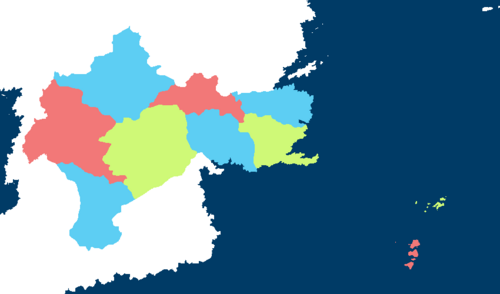Ăpalia: Difference between revisions
| Line 142: | Line 142: | ||
However, as the communist state consolidated its power, a leader emerged within the ranks of the PWP who possessed a ruthless ambition and authoritarian tendencies. This leader was Isoh Alahos, and he capitalized on the chaotic post-war period and the lingering divisions within society to consolidate his own authority. | However, as the communist state consolidated its power, a leader emerged within the ranks of the PWP who possessed a ruthless ambition and authoritarian tendencies. This leader was Isoh Alahos, and he capitalized on the chaotic post-war period and the lingering divisions within society to consolidate his own authority. | ||
Alahos, known for his strong leadership skills and manipulation, gradually marginalized dissenting voices within the PWP and consolidated power in his hands. Drawing inspiration from figures like Tohen Karal, Alahos established a cult of personality, presenting himself as the savior of the revolution and the guardian of the state's interests. | |||
====Harsh Reforms and Suppression of Cultural Differences==== | ====Harsh Reforms and Suppression of Cultural Differences==== | ||
Revision as of 20:16, 11 June 2023
Ăpali Union Kupu Ăpali | |
|---|---|
 Political map of the Ăpali Union | |
| Capital | Isagu |
| Official languages | Ăpali |
| Recognised national languages | Ăpali |
| Recognised regional languages | Anta |
| Ethnic groups | Ăpali, Anta |
| Demonym(s) | Ăpali |
| Government | Federal Republic |
• President | Sohen Hoseci |
| Population | |
• Estimate | 212,850,000 |
• Density | 44/km2 (114.0/sq mi) |
| Currency | Boreal Mark |
| Driving side | right |
History
A Former Colony (1706-1923)
Foundations of a New Land
In the year 1706, a group of intrepid pioneers from the Shasvin Empire set foot on the shores of Cikras, laying the cornerstone for the city of Isagu. Their ambitious spirit drove them to expand further, venturing into the unexplored depths of the continent. By 1707, they had established a firm foothold, gradually pushing through the dense nature as they ventured deeper into the heart of this new land.
The Anta Conflict and Annexation
As the colonists ventured into the vast continent, with their eyes set on untapped riches and new territories to claim, they encountered the Anta, a resilient and proud people who called the towering mountains their home.
The Anta, deeply connected to their ancestral lands and wary of outsiders, resisted the encroachment of the colonists. They defended their mountainous domain with determination, using their intimate knowledge of the rugged terrain to their advantage. The clash between the Anta and the expanding empire marked the beginning of a protracted conflict, as the two forces grappled for control of the range.
The empire, driven by a relentless desire to exploit the abundant resources hidden within the mountains, made substantial effots to subjugate the Anta. In 1815, the conflict led to a brutal and hard-fought war, where the empire's technological advancements clashed with the Anta's deep connection to their natural surroundings. In the end, the empire emerged triumphant, claiming victory over the Anta and bringing the mountainous region under its rule.
With the annexation of the Anta lands in 1822, the empire gained control over valuable resources such as precious minerals and fertile lands. However, it is important to note that despite their subjugation, the Anta's cultural identity and language were preserved. This pivotal event in history not only solidified the empire's dominance in the region but also marked a significant turning point in the relationship between the empire and the Anta people, shaping their interactions and dynamics for generations to come.
The Era of Sovereign States (1923-2141)
The collapse of the Shasvin Empire in 1923 marked a turning point in Ăpalia's history. The once-unified colony splintered into various sovereign states that would come to be known as the Ăpali states. The Anta regained the control over their ancestral lands that had been taken from them centuries ago. The term "Ăpali" originated from the phrase "Ă et ep nasali" in the Parkjol Saspí language, which literally translates to "speech with ă." Initially, this phrase was used by the Shasvin Empire to denote the unique dialect spoken in the colony, characterized by the emergence of the vowel ă. However, with the empire gone, the phrase took on a new significance as a symbol of identity.
During the era of sovereign states that spanned the two centuries between the collapse of the Shasvin Empire and the unification of the Ăpali states, various significant events and conflicts shaped the course of Ăpalia's history. These events served as catalysts for the eventual desire for a united nation.
The initial rivalries (1923-1960)
After the fall of the Shasvin Empire, the colony fragmented into multiple sovereign states. Each state, driven by its own interests and ambitions, sought to establish its independence and carve out its own destiny. The initial years were marked by border disputes, territorial conflicts, and power struggles between neighboring states. These conflicts often arose due to resource competition and differing political ideologies. Economic rivalries emerged as states vied for control over trade routes, natural resources, and strategic locations. These rivalries sometimes escalated into localized conflicts and skirmishes.
The Great Eastern Conflict (1975-1992)
The Great Eastern Conflict was a prolonged war between the states of the eastern region of Ăpalia. It was triggered by a dispute over control of key river routes and trade centers. The conflict involved shifting alliances and fierce battles, resulting in significant loss of life and economic instability in the region. The war continued for over a decade before a peace treaty was finally negotiated, leading to a period of relative stability.
The Mountain Wars (2020-2045)
The Mountain Wars were a series of conflicts between several states and the Anta tribes inhabiting the mountainous regions of Ăpalia. The wars were fueled by disputes over land ownership, access to valuable resources, and conflicting cultural interests. Both sides engaged in guerrilla warfare and utilized their respective knowledge of the terrain to their advantage. The protracted nature of the Mountain Wars and the hardships endured by both the states and the Anta tribes highlighted the need for a more cohesive and unified approach to governance and conflict resolution.
The Great Drought and Famine (2058-2094)
The Ăpali states faced a severe drought that lasted several years, leading to widespread crop failures and food shortages across the states. The scarcity of water and agricultural resources resulted in a devastating famine, causing significant suffering and loss of life among the population. The states struggled to provide relief and support to their citizens, exacerbating existing tensions and economic disparities between regions. This crisis highlighted the vulnerability of the states' agricultural systems and the need for stronger collaboration and resource management in the face of environmental challenges. It served as a wake-up call for increased cooperation and economic integration among the states to ensure the well-being and survival of their populations.
The Crisis of Trade (2110-2125)
The Crisis of Trade emerged as a result of increasing tensions and competition among the Ăpali states for trade dominance. Trade disputes and economic protectionism led to a series of trade embargoes and tariffs imposed by different states against each other. This resulted in a decline in overall economic growth and strained inter-state relations. The Crisis of Trade brought to the forefront the need for a unified trade policy and a common platform to address economic issues collectively. These conflicts, among others, gradually revealed the limitations of a fragmented Ăpali landscape. The desire for stability, economic prosperity, and mutual cooperation grew among the states, leading to the emergence of the unification movement in the late 2100s. The experiences of war, territorial disputes, and economic hardships provided the impetus for the Ăpali people to seek a united nation that could effectively address these challenges and forge a brighter future together.
The First Unification (2141-2175)
Towards Unity and Transformation
In the late 22nd century, the states have been contemplating the idea of a unified nation helping keep peace and balance. The last two hundred years had been filled with disputes and conflicts. A unification movement spearheaded by Tohen Karal emerged, advocating for a greater unified state that would encompass all the regions. The movement gained traction, fueled by the shared understanding that a unified nation could unlock new opportunities for prosperity and growth. In 2141, the movement hit its culminating point with the creation of the Ăpali Union. A federal union with a central government but retaining autonomy for the states.
The reintegration of the Anta
After the fall of the Shasvin Empire and the subsequent dissolution of the colony, the Anta people regained control of their lands. The process of reintegrating the Anta into the newly formed Ăpali Union required delicate negotiations and a commitment to mutual understanding. The negotiations focused on finding common ground and shared interests. The Ăpali government acknowledged the invaluable knowledge and wisdom of the Anta regarding the mountains and their resources. In exchange for the Anta joining the union, the government offered technological advancements and support for the development and preservation of the Anta's unique culture. The outcome of the negotiations were three new mountainous states within the Ăpali Union, each loosely representing a major Anta tribe. These states were granted a high degree of autonomy, allowing the Anta people to govern themselves and maintain their cultural practices. Additionally, the agreement stipulated that the Ăpali people could freely migrate to these states in search of a better future, fostering cultural exchange and integration.
Through these negotiations, the Anta people became an integral part of the Ăpali Union, contributing their rich cultural heritage and knowledge of the mountains. The process of reintegration was founded on respect, cooperation, and a shared commitment to building a unified nation that values diversity and inclusivity.
The flaws of the union
Struggles for Political Power
Following the unification, various political parties emerged, each representing different ideologies and visions for the nation. The competition for political power intensified as these parties sought to shape the direction of the unified Ăpali Union. The struggle for political dominance among the parties led to a climate of rivalry, mistrust, and corruption. Political leaders, driven by personal ambition and greed, vied for control over key positions within the government, sparking power struggles and undermining the stability of the nation.
Socioeconomic Inequalities
The process of unification did not immediately address the socioeconomic disparities that existed among the different regions and social classes within Ăpalia. Economic disparities and unequal distribution of resources created tensions and fostered a sense of discontent among marginalized communities. The concentration of wealth and power in certain regions or among specific social groups exacerbated social divisions, leading to growing resentment and demands for greater equality and social justice.
Cultural and Regional Identities
The process of unification brought together states that had developed distinct regional identities, cultural practices, and linguistic variations. While efforts were made to forge a sense of national identity, challenges arose in reconciling these diverse cultural backgrounds. Some regions felt marginalized or overlooked in decision-making processes, leading to feelings of cultural suppression and resentment. Calls for regional autonomy and preservation of cultural heritage heightened the tensions within the nation.
Ideological Clashes
The different political parties that emerged after unification espoused competing ideologies and visions for Ăpalia. Disagreements over the balance of power between the federal government and the states, as well as conflicting views on individual freedoms and centralized authority, created ideological fault lines. The leaders of these parties, driven by their own agendas and personal ambitions, employed propaganda and manipulation to sway public opinion. This further polarized society and fueled mistrust between the factions.
These cumulative factors, including struggles for political power, socioeconomic inequalities, cultural and regional identities, and ideological clashes, created a volatile environment within Ăpalia. As the tensions escalated and grievances mounted, the stage was set for the outbreak of the civil war in 2175. The civil war became a violent manifestation of these deep-seated conflicts and a struggle for control over the direction and governance of the newly unified nation.
The Ăpali Civil War (2175-2197)
Setting the Stage
In the late 2100s, Ăpalia was torn apart by a civil war caused by a deep divide between two groups: the unionists and the liberals. Both sides were corrupted by greed and wanted complete control over the government, leading to a violent conflict that shaped the nation's history. The war began because the unionists wanted a stronger central government to ensure unity, while the liberals wanted more freedom and power for the individual states. Their differing ideas led to increased tensions and clashes. Selfish leaders from both sides used their positions for personal gain, which eroded trust in the government and worsened the divisions within society. As corruption flourished, propaganda and lies were used to manipulate young people and deepen the ideological divide. Eventually, the situation exploded into war, with unionist and liberal forces fighting fiercely for control, plunging Ăpalia into chaos.
Soldiers Turn Against Corruption
In 2197, during the conflict, unionist soldiers, tired of the war and disgusted by their own leaders' greed, rebelled against their high-ranking commanders. Betrayed by those they once trusted, the soldiers took action against the corrupt leadership, seeking justice and an end to the senseless violence. News of the soldiers' revolt spread, bringing hope to the liberal faction. Recognizing their shared disdain for corruption, the liberals eliminated their commanders as well. When the puppeteers of the war were gone and the army was in the hands of the people, representatives from both sides came together to negotiate peace and implement reforms. They acknowledged the need to address corruption and promote transparency, working towards a renewed federal system with strict regulations and oversight. Out of the war's aftermath, a reformed federal system was established. The new government learned from past mistakes, emphasizing checks and balances, granting more power to the states, and promoting accountability. While central authority remained, it was balanced by respect for regional autonomy and state rights. However, this system of government would not last longer than a year as the idea of communism lurked close by.
The Rise of a Communist State (2197-2210)
In the aftermath of the devastating civil war, a radical faction emerged within the Ăpali Union advocating for a complete overhaul of the existing political and economic systems. This faction, known as the Progressive Workers' Party (PWP), gained considerable influence and support among the war-weary population, especially among those who had suffered the most from the corrupt practices of the previous government. Their vision was to create a classless society, where wealth and power were distributed equally among all citizens.
The PWP, led by charismatic and ideologically fervent leaders, successfully mobilized the disillusioned masses by promising equality, social justice, and an end to the cultural and regional divisions that had plagued Ăpalia. Their platform resonated with the working class and those who felt marginalized by the previous system. Through extensive propaganda and grassroots organizing, they rallied support and gained control over key institutions, including the military and the media.
Establishment of a Communist Union
In 2197, the Progressive Workers' Party implemented a series of sweeping reforms that reshaped the Ăpali Union into a communist state, officially named the People's Republic of Ăpalia. The former states within the union were transformed into autonomous republics, with their respective capitals serving as regional centers of government. The central authority was consolidated under the PWP, which governed from the capital city.
The principles of socialism and communism were emphasized, with the state taking control of major industries and resources. Private property was abolished, and land and wealth were redistributed among the population. The government implemented policies aimed at eradicating socioeconomic disparities and promoting collective ownership and decision-making. The PWP sought to create a society based on the principles of equality, solidarity, and common welfare.
The Rise of Isoh Alahos
However, as the communist state consolidated its power, a leader emerged within the ranks of the PWP who possessed a ruthless ambition and authoritarian tendencies. This leader was Isoh Alahos, and he capitalized on the chaotic post-war period and the lingering divisions within society to consolidate his own authority.
Alahos, known for his strong leadership skills and manipulation, gradually marginalized dissenting voices within the PWP and consolidated power in his hands. Drawing inspiration from figures like Tohen Karal, Alahos established a cult of personality, presenting himself as the savior of the revolution and the guardian of the state's interests.
Harsh Reforms and Suppression of Cultural Differences
Under Radkov's leadership, the People's Republic of Ăpalia underwent a radical transformation. The pursuit of communism became synonymous with strict conformity, and any form of dissent or deviation from the prescribed ideology was ruthlessly suppressed. Intellectuals, artists, and cultural figures who expressed ideas or promoted practices deemed counter-revolutionary were purged or silenced.
In an effort to forge a homogenous society, Radkov implemented harsh policies to suppress cultural differences. Regional identities and languages were discouraged, and a standardized national culture was promoted. Those who resisted or sought to preserve their unique cultural heritage were subjected to persecution and forced assimilation.
The totalitarian regime implemented a command economy, where the central government had full control over production, distribution, and resource allocation. While initial reforms aimed at improving the standard of living and addressing inequalities, the harsh reality of the centralized system led to widespread shortages, economic stagnation, and a decline in personal freedoms.

